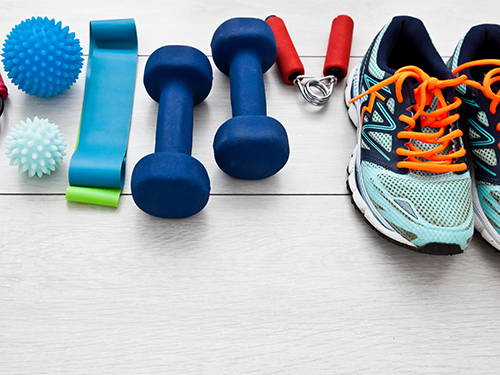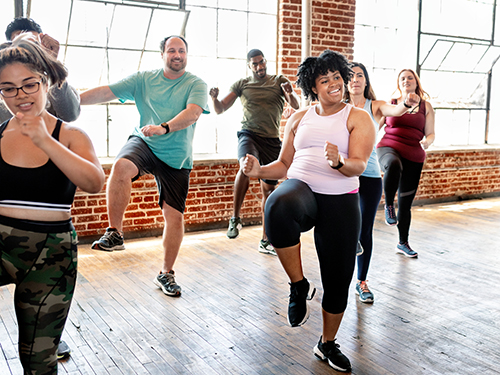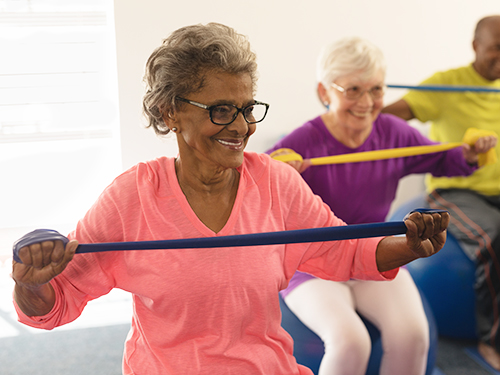
Fact Sheet FS1120
"Exercise is the key not only to physical health but to peace of mind" – Nelson Mandela
The 2022 Behavioral Risk Factor Surveillance System (BRFSS) questionnaire created by the Centers for Disease Control and Prevention (CDC) found between 17.3% and 47.7% of the adult population are physically inactive depending on specific geographic regions, ethnicity, and race. This lack of participation in leisure-time physical activity demonstrates the sedentary lifestyle of many Americans. Sedentary lifestyles are associated with $117 billion in healthcare costs annually and are reported to be the cause of 1 in 10 premature deaths according to the CDC. Regular physical activity can reduce the incidence of chronic disease and provide a sense of well-being. The Physical Activity Guidelines for Americans (PAGA) has a general recommendation for adults to achieve a minimum of 150 to 300 minutes of aerobic exercise each week and an additional two days that include muscle strengthening exercises. Recommendations are spanned over the week to provide ample opportunities for adults to meet the minimum requirements. It is important to check with your doctor before beginning a new physical activity routine of any type.
Types of Physical Activities
Physical activity is grouped into two specific types – aerobic or cardiovascular and muscle strengthening, commonly referred to as resistance training. Both provide beneficial forms of movement to prevent chronic disease and maintain a healthy lifestyle. Cardiovascular or aerobic exercise is the movement of muscle groups in the body over a sustained period in a systematic rhythm. Muscle strengthening or weight bearing activities are repetitive in nature and consist of movement that requires lifting objects that are heavier than objects we lift doing everyday activities. When doing muscle strengthening activities, it is important to work all major muscle groups, including upper body (arms, chest, shoulders), lower body (glutes, hamstrings, quadriceps, calves) and trunk (back, core, abdomen). While cardiovascular exercise should be done for 150–300 minutes weekly there is not a set amount of time to do muscle strengthening exercises, but they should be done twice per week.
Strength training exercises should be done in sets of 8–12 repetitions of the same movement. Stop doing that exercise when you can no longer do at least half of a full set of repetitions. For example, if you are doing bicep curls – 3 sets of 8 repetitions, on the fourth set if you can only do 2 bicep curls safely and with proper form, then move on to your next exercise. Other physical activities that can support a healthy body include practicing balance and flexibility, and those that help to maintain bone mineral density. These three forms of movement do not have a recommended level, however they are often part of aerobic or muscle strengthening physical activity, such as yoga, that supports muscle movement, flexibility, and balance. Engaging in balance, bone strengthening, and flexibility activities can protect joints, muscles and tendons while improving posture, mobility and flexibility and may even reduce joint pain. These activities are also instrumental in preventing falls as we age.
Physical Activity Intensity Levels
Aerobic physical activity is generally classified as moderate or vigorous intensity levels. Moderate physical activities increase both heart rate and breathing. If a person has not participated in any physical activities for a long time, it is important to start off slowly with moderate activities, and to check with a physician first. Walking "briskly" or doing yard work are examples of moderate physical activities. Vigorous activities are those that raise a person's heart rate rather quickly and tend to burn more calories than moderate activities. Aerobic dance and running are examples of vigorous activities. It is important that a person gradually works up to participate in vigorous activities. Participating in either moderate or vigorous activities is fine and so is a combination of both. Vigorous activities do serve as a greater intensity and vigorous activity for one minute is the equivalent of two minutes of moderate intensity movement.
Physical Activity Choices
Physical activity does not require a large commitment of time or money, can be done in various segments of time and be completed just about anywhere it is safe to do so. Walking around the block with a family member or friend not only provides the benefit of being physically active but can also contribute to building a close relationship with those walking partners. Neighborhood kickball or volleyball games help make bones and muscles grow stronger while also allowing communities to come together. These types of activities can be free and fun at the same time. Some activities may require going to a local park or recreation center. Special equipment or facilities may be needed for activities such as tennis, ice skating or rock climbing. In some cases, a small fee may also be required. Various sports leagues such as soccer, tennis and basketball occur throughout the year. Many communities offer classes and activities year-round and can support doing a variety of exercises to keep interest and make physical activity more enjoyable.
The Move Your Way Campaign developed by the United States Department of Health and Human Services encourages Americans to find movement in varying increments and in ways that are appealing to the individual. The program provides an interactive platform to assist with choosing movement that fits within individual interests and lifestyles. The activity planner focuses on the amount of time, type of physical activity and even who you wish to move with. Planning movement and doing pleasurable physical activity will make it a regular and fun habit. Visit Activity Planner - Move Your Way | health.gov to make a movement plan that works for you.
Benefits of Physical Activity
Regular physical activity can have a positive impact on overall quality of life, both physically and mentally.
Making Physical Activity a Priority
Finding time to be physically active can be a challenge but engaging in even ten minutes of moderate physical activity at once or any amount of vigorous activity can be beneficial. There is no need to spend a lot of money on equipment, nor is there any reason to make major changes to one's daily routine to start to make physical activity a regular habit. In fact, many of the things that people do in their daily lives may just need some fine tuning to help them work towards becoming more physically active.
Stay motivated to be physically active regularly and to be fit, prevent chronic disease, and maintain a healthy weight. Plan and be aware of what works to keep you moving and motivated.
Starting out slow may be necessary to achieve the recommended amount of physical activity each day. Add new activities gradually and with the advice of a health care professional if you have not recently been active.
Everyone can benefit from being physically active. If a person has a physical disability that limits them from doing some of the activities that have been mentioned here, speak to a doctor to develop a physical activity plan that is beneficial for you.
For More Information
| Moderate Intensity Activities | Vigorous Intensity Activities |
|---|---|
| Walking briskly (2.5 miles per hour or faster) | Jogging or running |
| Recreational swimming | Swimming laps |
| Bicycling slower than 20 mph on level terrain | Bicycling faster than 10 mph |
| Tennis Doubles | Tennis (singles) |
| Ballroom or line dancing | Vigorous dancing |
| Active forms of yoga | Jumping rope |
| General yard work | Heavy yard work (digging -heart rate increases) |
| Water aerobics exercise class | Vigorous exercise class (step aerobics or kick boxing) |
Adapted from Physical Activity Guidelines for Americans
| Moderate Intensity Activities | Vigorous Intensity Activities |
|---|---|
| Strength training with equipment | Strength training using body weight for resistance |
| Weightlifting | Push-ups |
| Pilates | Sit-ups |
| Resistance Bands | Lunges |
| Gardening that requires lifting heavy loads | Squats |
Adapted from Physical Activity Guidelines for Americans
Acknowledgement
This fact sheet has been updated from the original version written by Sherri Cirignano and Emily Maughn.
References
April 2024
Copyright © 2025 Rutgers, The State University of New Jersey. All rights reserved.
For more information: njaes.rutgers.edu.
Cooperating Agencies: Rutgers, The State University of New Jersey, U.S. Department of Agriculture, and Boards of County Commissioners. Rutgers Cooperative Extension, a unit of the Rutgers New Jersey Agricultural Experiment Station, is an equal opportunity program provider and employer.



